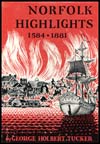Chapter 49
Norfolk's Two Civil War Monuments
Norfolk has two Civil War monuments -- the well-known Confederate Monument re-erected early in 1971 near its original site downtown adjacent to today's Bank of America building, and the lesser-known memorial dedicated to African-American Civil War Army and Navy veterans that dominates West Point Cemetery adjoining Elmwood Cemetery, north of Princess Anne Road.
Long-cherished hopes of erecting a Confederate monument in Norfolk became a reality early in 1898 when sufficient funds had been raised to make it possible.
On January 28, 1898, permission was granted by the City of Norfolk to use the space at the head of Commercial Place (earlier known as Market Square) on which it was erected. And on February 22, 1899, the cornerstone was laid on the thirty-second anniversary of the inauguration of Jefferson Davis as president of the Confederacy.
The monument was designed by the Couper Marble Works of Norfolk. The original plan called for it to be topped with a heroic bronze figure of Peace, while four life-sized bronze figures representing a Confederate sailor, infantryman, cavalryman, and artilleryman were intended to adorn the base. But money was scarce, and the committee finally settled for a handsome fifteen-foot bronze statue of a defiant Johnny Reb by Norfolk-born sculptor William Couper as the crowning feature of the monument that was unveiled on May 16, 1907.
Originally a focal point in the downtown area, the monument was a symbol in bronze and stone of the Lost Cause. But eventually the tides of progress abandoned it, and in 1924 a proposal was made to move it to another location.
This caused a resounding chorus of rebel yells, notable among them the hue and cry raised by the late Mrs. Frank Anthony Walke, popularly known as "Mrs. Confederacy." With fire in her eyes, Mrs. Walke defied the city fathers so effectively that they dropped the matter like a hot potato, or rather a hot minie ball. In June of 1954, the matter was again broached, at which time Norfolk Mayor W. Fred Duckworth aroused the ire of the United Daughters of the Confederacy when he referred to the monument as a "glorified pigeon roost." But it was not until 1964-65 that the monument was finally taken down for fear that it would be damaged by the pile drivers preparing the foundations for the Virginia National Bank Building (now the Bank of America building).
Cleaned and re-erected six years later, the monument now provides a pleasing contrast to the functional architecture that surrounds it.
James E. Fuller (1846-1909) of Norfolk, a former slave and a former quartermaster in the First United States Colored Cavalry, was the motivating spirit behind the erection of Norfolk's African-American Civil War Memorial. An employee of the Norfolk Customs House, Fuller was largely responsible for the City Council's granting of a portion of the West Point Cemetery in 1886 as a special burial place for black Union veterans.
Depending on chicken pot pie suppers, raffles, and concerts to raise funds, the committee headed by Fuller finally had enough money to begin the monument in 1906. The cornerstone was laid on decoration Day the same year. Completed in 1920, the monument is topped by a brown metal statue of a black Union private wearing a kepi, a tightly buttoned tunic, a sholder strap bearing the initials "U.S.A.," ribbed stockings, and heavy shoes.
Backed by a simulated wooden stump, the figure holds a regulation Civil War rifle and has a replica of a bayonet attached to his belt.
White marble plaques inserted in the monument's base record the names of the Grand Army of the Republic camps and other African-American groups which contributed to the memorial's completion.
Chapter
50
Norfolk's Early Jewish History
Norfolk Highlights 1584 - 1881

See the "Table of Contents" for links to every chapter in Norfolk Highlights 1584 - 1881 by George Holbert Tucker.
